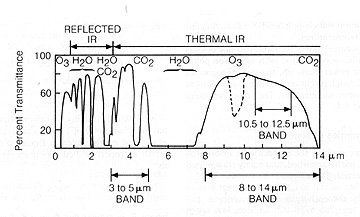THE WARM EARTH: THERMAL REMOTE SENSING¶
Contents
The Earth�s surface and atmosphere radiate thermal energy outward owing to heating by solar irradiation and by internal heat flow (generally a very minor contribution). Sensors that measure this emitted radiation in parts of the thermal region of the spectrum can produce very informative data (especially as images) that provide both distinctive signatures and ,indirectly, indications of properties of materials that are diagnostic. The atmospheric windows passing thermal radiation are indicated. The Planck Blackbody Radiation Law, the basis for thermal remote sensing, is presented.
THE WARM EARTH: THERMAL REMOTE SENSING¶
We have already shown several previews of imagery that depict the thermal state of the Earth’s surface. The Landsat Thematic Mapper band 6 produces images that show the relative differences in emitted thermal energy from surfaces of varying nature and orientation. On page 1-3, we showed this effect in the obviously warmer slopes in the Morro Bay scene and in Section 2, page 2-4 the surprisingly cool surfaces of the bright, white sandstone at the Waterpocket Fold. In seeming contradiction, the warmer surfaces associated with dark shales showed clearly in the Waterpocket Fold image. As we shall show, these thermal effects also differ, sometimes drastically, in images taken during the warmer days and cooler nights. This is clearly the case in this airborne thermal scanner image of a valley-mountain terrain in southern California, in which the same features may appear in sharply contrasting tones between the dawn and day scenes:
One usually obtains considerable information from thermal imagery, especially that generated as multispectral images. Some of this information supplements images obtained from reflected radiation and some stands alone as an information source. In this section review, we delve rather extensively into the theory and practice of thermal remote sensing and examine some striking examples obtained from land and water targets. However, we postpone our discussion of using thermal sensors to obtain temperature profiles or find other thermal properties in the atmosphere until we consider meteorological satellites (Section 14).
Remote sensing of direct temperature effects is carried out by sensing radiation emitted from matter in the thermal infrared region of the spectrum. Most thermal sensing of solids and liquids occurs in two atmospheric windows, where absorption is a minimum, as shown in this spectral plot taken from Sabins (Remote Sensing: Principles and Interpretation, 1987).
The windows normally used from aircraft platforms are in the 3-5 µm and 8-14 µm wavelength regions. Space borne sensors commonly use windows between 3 and 4 µm and between 10.5-12.5 µm. None of the windows transmits 100 percent because water vapor and carbon dioxide absorb some of the energy across the spectrum and ozone absorbs energy in the 10.5-12.5 µm interval. In addition, solar reflectance contaminates the 3-4 µm window to some degree during daylight hours, so we use it for Earth studies only when measurements are made at night.
Planck Radiation (Blackbody) Law¶
A perfect Blackbody is the concept of an ideal material that completely absorbs all incident radiation, converting it to internal energy. Therefore it does not permit any transmittance or reflectance but emits (re-radiates) the absorbed energy at the maximum possible rate per unit area. The amount of this radiant energy varies with temperature and wavelength(s).
In 1900, Max Planck published a paper on the thermal properties of blackbodies that became one of the foundation stones from which quantum physics was built on. The Planck Radiation Law gives the rate at which Blackbody objects radiate thermal energy:
Depending on what terms (parameters) and unit systems are used, the Planck equation can be written in various ways. As often used in remote sensing calculations, this differential form is given as:



